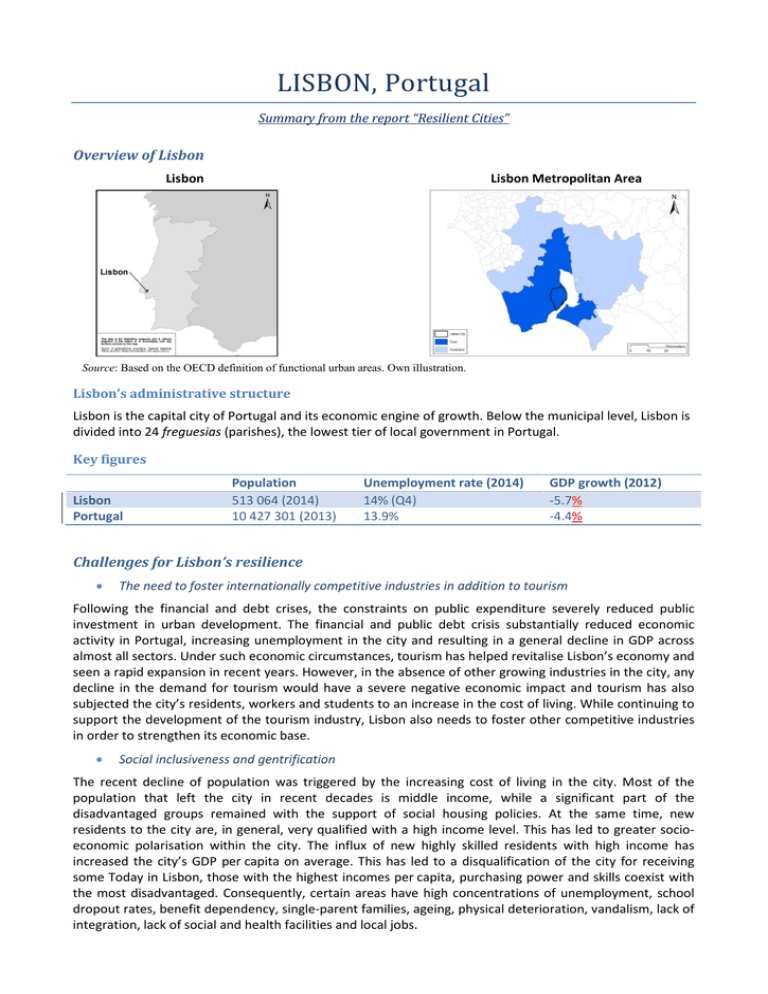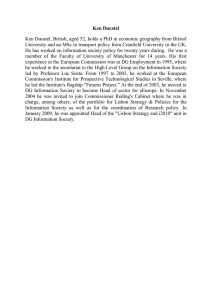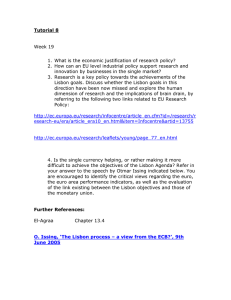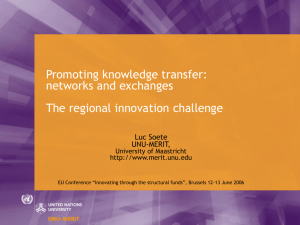LISBON, Portugal
advertisement

LISBON, Portugal Summary from the report “Resilient Cities” Overview of Lisbon Lisbon Lisbon Metropolitan Area Source: Based on the OECD definition of functional urban areas. Own illustration. Lisbon’s administrative structure Lisbon is the capital city of Portugal and its economic engine of growth. Below the municipal level, Lisbon is divided into 24 freguesias (parishes), the lowest tier of local government in Portugal. Key figures Lisbon Portugal Population 513 064 (2014) 10 427 301 (2013) Unemployment rate (2014) 14% (Q4) 13.9% GDP growth (2012) -5.7% -4.4% Challenges for Lisbon’s resilience • The need to foster internationally competitive industries in addition to tourism Following the financial and debt crises, the constraints on public expenditure severely reduced public investment in urban development. The financial and public debt crisis substantially reduced economic activity in Portugal, increasing unemployment in the city and resulting in a general decline in GDP across almost all sectors. Under such economic circumstances, tourism has helped revitalise Lisbon’s economy and seen a rapid expansion in recent years. However, in the absence of other growing industries in the city, any decline in the demand for tourism would have a severe negative economic impact and tourism has also subjected the city’s residents, workers and students to an increase in the cost of living. While continuing to support the development of the tourism industry, Lisbon also needs to foster other competitive industries in order to strengthen its economic base. • Social inclusiveness and gentrification The recent decline of population was triggered by the increasing cost of living in the city. Most of the population that left the city in recent decades is middle income, while a significant part of the disadvantaged groups remained with the support of social housing policies. At the same time, new residents to the city are, in general, very qualified with a high income level. This has led to greater socioeconomic polarisation within the city. The influx of new highly skilled residents with high income has increased the city’s GDP per capita on average. This has led to a disqualification of the city for receiving some Today in Lisbon, those with the highest incomes per capita, purchasing power and skills coexist with the most disadvantaged. Consequently, certain areas have high concentrations of unemployment, school dropout rates, benefit dependency, single-parent families, ageing, physical deterioration, vandalism, lack of integration, lack of social and health facilities and local jobs. Elements for building resilience in Lisbon Economy • • • • Various economic strategies are in place to facilitate growth and the creation of jobs. The goal of the city’s economic strategy for 2030 is to promote Lisbon as one of Europe’s most competitive, innovative and creative cities. Attracting investment to develop the city’s economy with the help of “Invest Lisboa”, the investment promotion agency of the city created through a partnership with the City Council and the Portuguese Chamber of Commerce. Support to boost the existing local sectors is provided by the City Council with business associations and the Chamber of Commerce of Portugal. Entrepreneurship is also encouraged through various programmes, such as the Startup Lisboa (2011), the Lisbon Empreende programme (2013) that promote entrepreneurship for the young and elderly, and the United at Work programme (2013) that fosters inter-generational entrepreneurship initiatives. Society • • • The city council is engaging with local communities to mitigate the social disparities through the “Regulation of Municipal Support Assignment Lisbon” and the “BIP/ZIP Programme”; and fosters civic life engagement through the Municipal Council for Culture and Citizenship as well as the Municipal Council for Equality. Social policies are developed to support disadvantaged groups and the community, including the Social Emergency Fund of Lisbon and the Community Extinguishers Mouraria project to engage citizens in emergency response. The role of freguesias is important to building citizens’ networks in communities to promote social cohesion, notably the freguesias’ social commissions at the basis of the Social Network of Lisbon. Environment • Investments to improve the quality of life are in place through the development plans Plano de Desenvolvimento Social de Lisboa and the Agenda Estratégica 2013-2015 and investment programmes such as the Priority Investment Programme for Urban Rehabilitation. Institutions • • • The city’s strategic vision featuring the need to restore its economy is clearly stated in its longterm vision for 2013-20 and in the City Government Programme (2013-17) Coordination with the national agency to enhance policy coherence, ensured by a close relationship with the Lisbon Regional Coordination and Development Commission (CCDR-LVT). Administrative decentralisation reform to increase the responsibilities of freguesias under the BIP/ZIP Programme. Conclusions • The city of Lisbon can rely on the lower level governments, the freguesias, to funnel city resources more efficiently to people in need and initiatives that improve the quality of life in local communities. The freguesias also play a critical role in engaging citizens in local initiatives, and as such devolving more responsibilities to the freguesias has been a successful tool to allocate resources more efficiently. • To ensure a standard of living in the long run, better economic prospects and a higher degree of integration into the global economy are critical. Therefore, the investments the city is putting toward the diversification of its economy and to strengthen the evolution of entrepreneurial ecosystems will be beneficial to the city’s well-being in the future. • Examining the extent to which gentrification leads to the displacement of the local population is critical as well as understanding the mechanisms in the gentrification process that impact established neighbourhood communities. This could identify or suggest: 1) areas or ways that policies could be improved; 2) help to ensure the best use of available resources; and 3) help to identify how programmes can be effectively integrated into communities’ everyday lives.






